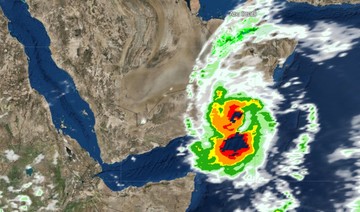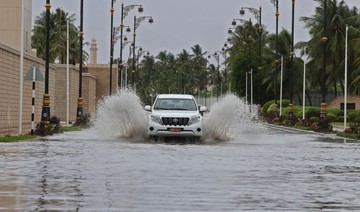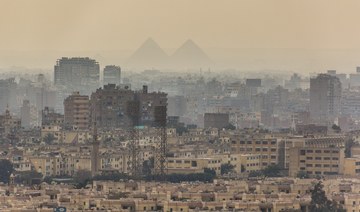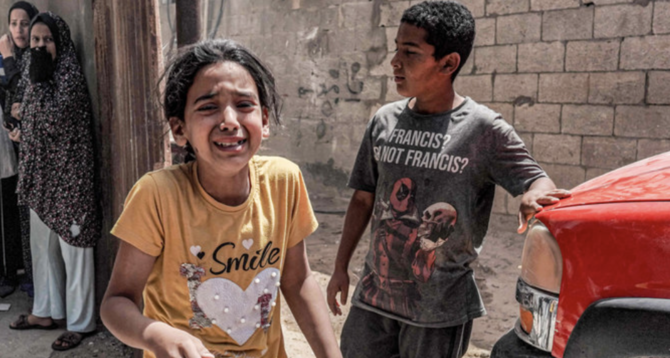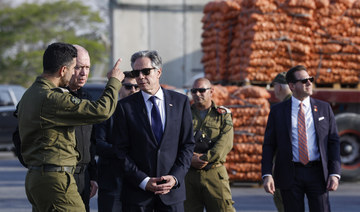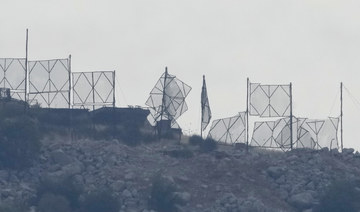DUBAI: Cyclone Mekunu was downgraded to a tropical storm on Saturday after lashing eastern Yemen and southern Oman, leaving several people dead in its wake and soaking arid Oman and Yemen under 200 ml of rainfall.
Latest satellite images, analysis of weather maps and the results of numerical models of the tropical cyclone Mekunu, in the Arabian Sea, have shown that it became a second class cyclone and expected to move north to northwest, with the storm eye away from Saudi Arabia, by about 350 kilometers and the wind speed around the center of the hurricane, to be between 157 to 167 km/h, according to the General Authority of Meteorology and Environment Protection (GAMEP).
The commission’s predictions indicate that the tropical situation, in Oman and the Republic of Yemen is likely to change.
As the cyclone has turned into a tropical storm, it may affect parts of Saudi Arabia from Saturday to next Tuesday.
Southern parts of the eastern desert of the Rubu Al-khali (the Empty Quarter) and the Eastern parts of Najran will be affected by torrential rains that may lead to flash floods and active winds of up to 75 km/h, in addition to dusty weather.
GAMEP called on everyone to follow up new reports on the situation, which may change course in the coming days, through the daily weather reports and alerts issued by the early warning system on the official website and the means of social communication.
Cyclone Mekunu caused flash flooding that tore away whole roadways and submerged others in Salalah, Oman’s third-largest city, stranding drivers. Strong winds knocked over street lights and tore away roofing.
Rushing waters from the rain and storm surges flooded typically dry creek beds. The holiday destination’s now-empty tourist beaches were littered with debris and foam from the churning Arabian Sea.
Three people, including a 12-year-old girl, died in Oman, and another two bodies were recovered from the Yemeni island of Socotra. More than 30 people were still missing in Socotra, including Yemeni, Indian and Sudanese nationals.
Yemeni officials also reported damage in the country’s far east, along the border with Oman. Rageh Bakrit, the governor of Al-Mahra province, said on his official Twitter account late Friday that strong winds had blown down houses and taken out communication lines and water services. He said there were no fatalities in the province.
India’s Meteorological Department said the storm packed maximum sustained winds of 170-180 kilometers (105-111 miles) per hour with gusts of up to 200 kph (124 mph). It called the cyclone “extremely severe.”
Portions of Salalah, home to some 200,000 people, lost power as the cyclone made landfall.
Branches and leaves littered the streets. Several underpasses became standing lakes. Some cars were left abandoned on the road. Electrical workers began trying to repair lines in the city while police and soldiers in SUVs patrolled the streets. On the outskirts of the city, near the Salalah International Airport, what once was a dry creek bed had become a raging river.
The airport, closed since Thursday, will reopen early Sunday, Oman’s Public Authority for Civil Aviation said. The Port of Salalah — a key gateway for the country and for Qatar amid a regional diplomatic dispute — remained closed, its cranes secured against the pounding rain and winds.
Omani forecasters said Salalah and the surrounding area would get at least 200 millimeters (7.87 inches) of rain, over twice the city’s annual downfall. It actually received 278.2 mm, nearly three times its annual rainfall.
Authorities remained worried about flash flooding in the area’s valleys and potential mudslides down its nearby cloud-shrouded mountains. In nearby Wadi Darbat, the storm’s rains supercharged its famous waterfall.
Police and others continued their rescue efforts even as the winds and rains calmed. Capt. Tarek Al-Shanfari of the Royal Oman Police’s public relations department said there had been at least three fatalities in the storm, including the death of a 12-year-old girl who was hit in the head by a door flung open by the wind.
An Asian laborer died in a flooded valley and an Omani national in a 4x4 died when his vehicle was swept away, Al-Shanfari said.
On Socotra, authorities relocated over 230 families to sturdier buildings and other areas, including those more inland and in the island’s mountains, Yemeni security officials said.
Flash floods engulfed Socotra’s streets, cutting electricity and communication lines. Some humanitarian aid from Saudi Arabia and the United Arab Emirates arrived on the island just hours after the cyclone receded.
Yemeni security officials said rescuers recovered two bodies on Socotra, while more than 30 people remain missing. They spoke on condition of anonymity because they were not authorized to brief reporters.
The island, listed by UNESCO as a World Heritage Site, has been the focus of a dispute between the UAE and Yemen’s internationally recognized government, which are ostensibly allied against Shiite rebels known as Houthis.
Socotra has a unique ecosystem and is home to plants, snails and reptiles that can be found nowhere else.
In Oman, Mohammed Omer Baomer warned his neighbors about a torn-away chunk of road just down the street from his home after earlier getting his SUV stuck over it.
“It was a scary feeling, as if it was the end of world,” he said of the cyclone. “You can’t even go outside. You try to watch from the window and you can’t.”
Yet even as Mekunu barreled overhead, the eye of the storm provided a moment’s respite early Saturday morning. At one luxury hotel in Salalah, which already had evacuated its guests, workers sat down early for “suhoor,” a meal Muslims eat before sunrise during the holy fasting month of Ramadan. They laughed and shared plates by flashlight in a darkened ballroom, the cyclone’s wind a dull roar behind their clatter.
His work can be found at http://apne.ws/2galNpz
Critical response units
“The past two days were really very critical and difficult for everyone to survive…For me, its personally the first time I am inside a cyclone,” Dr. Naif Bazzi, General Manager of Dhofar’s Rehabilitation center told Arab News, adding that “the rate of the readiness of the systems of the government, health, emergency etc.… everything was still working during the very critical times during the cyclone.”
“The civil defense and police and army were all around, whatever you want you could have and whatever you need to do they would help you – many phone numbers for people to ask for any kind of help, everything was arranged,” the Lebanese expat added.
“It is clear that the cyclone has gone away and we now have ordinary winter weather. In Salalah, lots of trees and lamp posts displaced but the life is coming back now to the streets and Dhofar region…its calm now and everyone is going out.”
UAE not to be affected
“According to the Medium Ranged Forecast from Numerical Weather Predictions, the tropical cyclone will not reach the UAE,” the UAE’s National Center of Meteorology said in a statement.
It added that however medium and high clouds and moist air mass may lead to convective cloud formations at times in the eastern and the southern parts of the country associated with fresh winds.
following up #CyclonicStormMekunu path updates in the #ArabianSea Saturday 26/5/2018 #mekunu
As predicted by the NCM the tropical Storm is descending from the second category to a tropical cyclone of the first category and no opportunities for direct impact on the UAE pic.twitter.com/2K0bDqScSv— المركز الوطني للأرصاد (@NCMS_media) May 25, 2018
(With AP, AFP)










